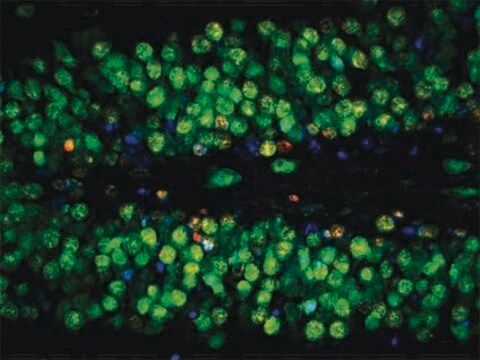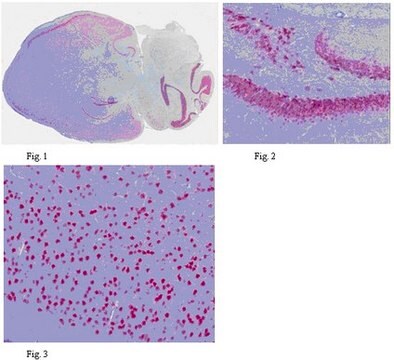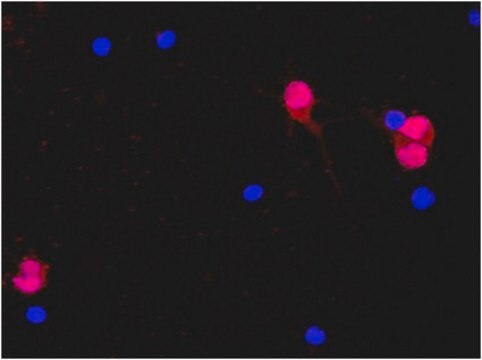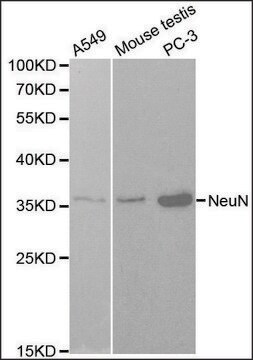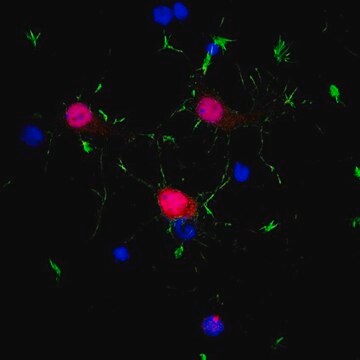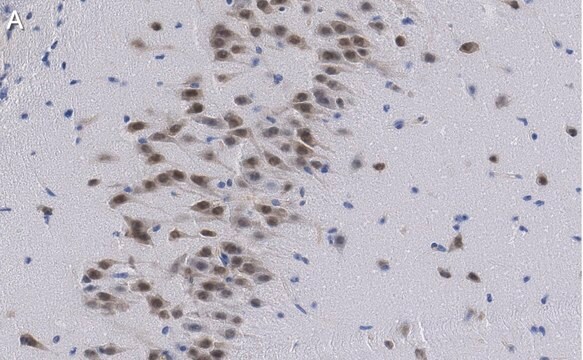MAB377B
Anti-NeuN Antibody, clone A60, biotin conjugated
clone A60, Chemicon®, from mouse
Synonim(y):
Neuron-Specific Nuclear Protein
About This Item
Polecane produkty
pochodzenie biologiczne
mouse
Poziom jakości
białko sprzężone
biotin conjugate
forma przeciwciała
purified immunoglobulin
rodzaj przeciwciała
primary antibodies
klon
A60, monoclonal
reaktywność gatunkowa
rat, mouse
reaktywność gatunkowa (przewidywana na podstawie homologii)
ferret, salamander, human, chicken
producent / nazwa handlowa
Chemicon®
metody
immunocytochemistry: suitable
immunohistochemistry (formalin-fixed, paraffin-embedded sections): suitable
western blot: suitable
izotyp
IgG1
Warunki transportu
wet ice
docelowa modyfikacja potranslacyjna
unmodified
informacje o genach
human ... RBFOX3(146713)
mouse ... Rbfox3(52897)
rat ... Rbfox3(287847)
Opis ogólny
Specyficzność
Immunogen
Zastosowanie
1:10-1:500 dilution of a previous lot was used. Neurons in culture should be permeablized with 0.1% triton X-100. All primary antibody dilutions should be performed with simple solutions containing only buffer and primary antibody without excess protein blocks or detergents.
For dual labeling studies using mouse monoclonals, antibody incubations should be sequential with MAB377B last. First mouse monoclonal antibody should be first detected with anti-mouse secondary prior to incubating with MAB377B. Excess anti-mouse IgG may be blocked by incubating with 1% mouse serum prior to MAB377B incubation. Detection of biotinylated NeuN monoclonal is via streptavidin. In some cases in may be necessary to pretreat the tissue with avidin to block excess biotin prior to immunohistochemisty (Wood and Warnke, 1981).
Immunohistochemistry:
1:200-1:2,000. The antibody works best on polyester wax embedded tissue but also works on paraffin embedded tissue at a lower working dilution. The antibody works well with formaldehyde-based fixatives. Citric acid and microwave pretreatment has been used successfully (Sarnat, 1998).
Western Blotting Analysis:
A previous lot of this antibody was used on western blot. Recognizes 2-3 bands in the 46-48 kDa range and possibly another band at approximately 66 kDa.
Optimal working dilutions must be determined by end user.
Neuroscience
Neuronal & Glial Markers
Jakość
Immunohistochemistry(paraffin) Analysis:
NeuN (cat. # MAB377B) staining pattern/morphology in rat cerebellum. Tissue pretreated with Citrate, pH 6.0. This lot of antibody was diluted to 1:100, using IHC-Select Detection with HRP-DAB. Immunoreactivity is seen as nuclear staining in the neurons in the granular layer. Note that there is no signal detected in the nucleus of Purkinje cells.
Optimal Staining With Citrate Buffer, pH 6.0, Epitope Retrieval: Rat Cerebellum
Opis wartości docelowych
Postać fizyczna
Przechowywanie i stabilność
Komentarz do analizy
Brain tissue, most neuronal cell types throughout the adult nervous system
Inne uwagi
Informacje prawne
Oświadczenie o zrzeczeniu się odpowiedzialności
Nie możesz znaleźć właściwego produktu?
Wypróbuj nasz Narzędzie selektora produktów.
Kod klasy składowania
12 - Non Combustible Liquids
Klasa zagrożenia wodnego (WGK)
WGK 2
Temperatura zapłonu (°F)
Not applicable
Temperatura zapłonu (°C)
Not applicable
Certyfikaty analizy (CoA)
Poszukaj Certyfikaty analizy (CoA), wpisując numer partii/serii produktów. Numery serii i partii można znaleźć na etykiecie produktu po słowach „seria” lub „partia”.
Masz już ten produkt?
Dokumenty związane z niedawno zakupionymi produktami zostały zamieszczone w Bibliotece dokumentów.
Klienci oglądali również te produkty
Nasz zespół naukowców ma doświadczenie we wszystkich obszarach badań, w tym w naukach przyrodniczych, materiałoznawstwie, syntezie chemicznej, chromatografii, analityce i wielu innych dziedzinach.
Skontaktuj się z zespołem ds. pomocy technicznej
